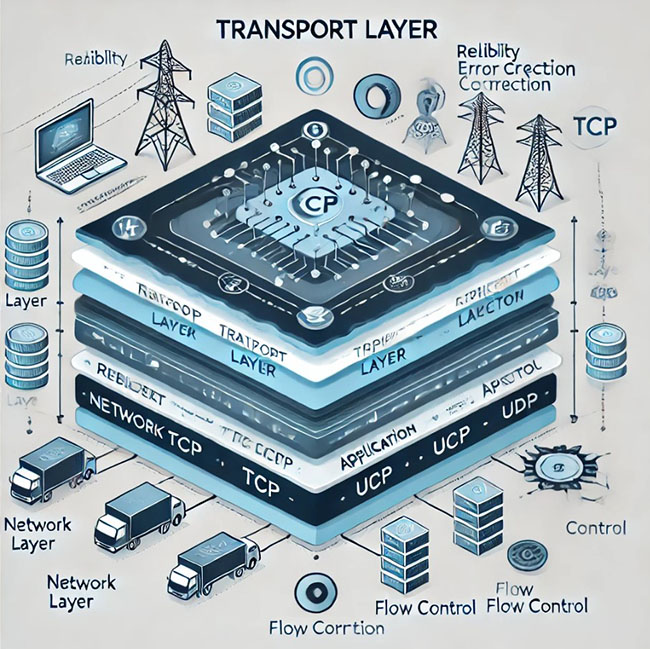The Important Role of the Transport Layer in Computer Networks
The transport layer plays a crucial role in computer networks by ensuring reliable data transmission between devices. Positioned between the network layer and the application layer in the OSI (Open Systems Interconnection) model, it is responsible for end-to-end communication management, error handling, and flow control. This article delves into the importance of the transport layer, its key functions, and how it helps maintain efficiency and reliability in computer networks.
What is the Transport Layer?
In the OSI model, the transport layer is the fourth of seven layers, situated between the network layer (layer 3) and the session layer (layer 5). The main purpose of the transport layer is to facilitate communication between two devices on a network, ensuring that data is transferred error-free, in sequence, and without losses or duplications. This layer manages data flow and congestion, ensuring that the receiving device is not overwhelmed by too much data at once.
Two of the most widely used transport layer protocols are:
- Transmission Control Protocol (TCP) – Provides reliable, connection-oriented communication.
- User Datagram Protocol (UDP) – Offers fast, connectionless communication without guaranteed reliability.
These protocols are essential for different applications, depending on the priority of speed or reliability.
Key Functions of the Transport Layer
The transport layer offers multiple functions that are vital for the proper functioning of a network. These functions ensure that communication between devices happens smoothly and without issues, especially over long distances and through multiple networks.
1. Segmentation and Reassembly
When a large chunk of data is to be transmitted, the transport layer divides it into smaller segments. Each segment contains a sequence number that helps reassemble the data correctly at the receiving end. This segmentation ensures that even if the data takes different routes to reach its destination, the receiver can properly reconstruct the original message.
2. Connection Control
The transport layer can be either connection-oriented or connectionless. TCP, for instance, is connection-oriented, meaning that it establishes a connection between two devices before data transmission occurs. This ensures that both devices are ready to send and receive data, and it provides a more reliable form of communication. UDP, on the other hand, is connectionless, allowing data to be sent without establishing a prior connection, thus speeding up communication but sacrificing reliability.
3. Error Control
Data transmission errors are inevitable in networks due to noise, interference, and other issues. The transport layer is responsible for error detection and correction. It uses checksums to detect errors, and if errors are found, the sender is informed to retransmit the corrupted segments. This ensures that the data received at the destination is free of errors.
4. Flow Control
Flow control is a mechanism used to prevent the sender from overwhelming the receiver with too much data at once. The transport layer ensures that the data flow rate matches the receiver’s ability to process the data. By managing flow control, the transport layer prevents network congestion and reduces the chances of packet loss.
5. Multiplexing and Demultiplexing
The transport layer enables multiple applications on the same device to share a single network connection. It does this by using ports to direct the data to the correct application. For example, web browsers use port 80 or 443 for HTTP and HTTPS, while email services might use port 25 for SMTP. The transport layer ensures that data reaches the appropriate application.
6. Congestion Control
Congestion occurs when too much data is sent through a network that cannot handle it, leading to packet loss and delays. The transport layer helps manage congestion by controlling the data transmission rate. TCP, for instance, uses congestion avoidance algorithms that adjust the rate of data transmission based on network conditions.
The Role of TCP and UDP in the Transport Layer
As mentioned earlier, TCP and UDP are the two main protocols of the transport layer. They serve different purposes and are used in different scenarios based on the network requirements.
Transmission Control Protocol (TCP)
TCP is a reliable, connection-oriented protocol. It ensures that data is delivered in sequence and without errors. TCP is ideal for applications where accuracy and reliability are crucial, such as web browsing, file transfers, and email communication. The protocol performs the following functions:
- Connection establishment and termination: TCP sets up a connection before data transfer and terminates it once the transfer is complete.
- Data sequencing: TCP ensures that the segments are reassembled in the correct order at the destination.
- Error checking and retransmission: TCP detects errors and, if necessary, retransmits corrupted segments.
- Congestion control: TCP adjusts its transmission rate based on the network’s capacity.
User Datagram Protocol (UDP)
UDP is a connectionless protocol that is faster than TCP but does not guarantee reliable delivery. It is typically used in applications where speed is more important than accuracy, such as online gaming, video streaming, and voice calls. UDP performs the following functions:
- Faster data transmission: Since no connection is established, data can be sent immediately.
- No error recovery: UDP does not perform retransmissions or guarantee the order of delivery.
- Lower overhead: UDP has less overhead than TCP, making it more efficient for applications that prioritize speed over reliability.
Why the Transport Layer is Critical for Network Performance
The transport layer ensures that data flows smoothly and efficiently between devices, even across vast distances and through various networks. Without the transport layer’s error handling, flow control, and congestion management, modern applications like web browsing, online gaming, and video conferencing would suffer from delays, errors, and packet losses.
The transport layer’s adaptability allows it to handle different types of data transmissions, from real-time communication, where speed is key, to sensitive applications like banking, where accuracy and reliability are paramount.
Conclusion
The transport layer plays a fundamental role in the architecture of computer networks. It bridges the gap between the lower layers, responsible for routing and data link transmission, and the upper layers, which deal with the end user’s data and application interaction. Whether you’re streaming a video, sending an email, or downloading a file, the transport layer is working behind the scenes to ensure your data is transmitted accurately and efficiently.
Understanding the transport layer’s role is essential for anyone involved in networking or IT, as it is crucial for ensuring the optimal performance and reliability of networks, both large and small.
This article outlines the critical role of the transport layer in computer networks, from managing connections and controlling data flow to preventing errors and congestion.



